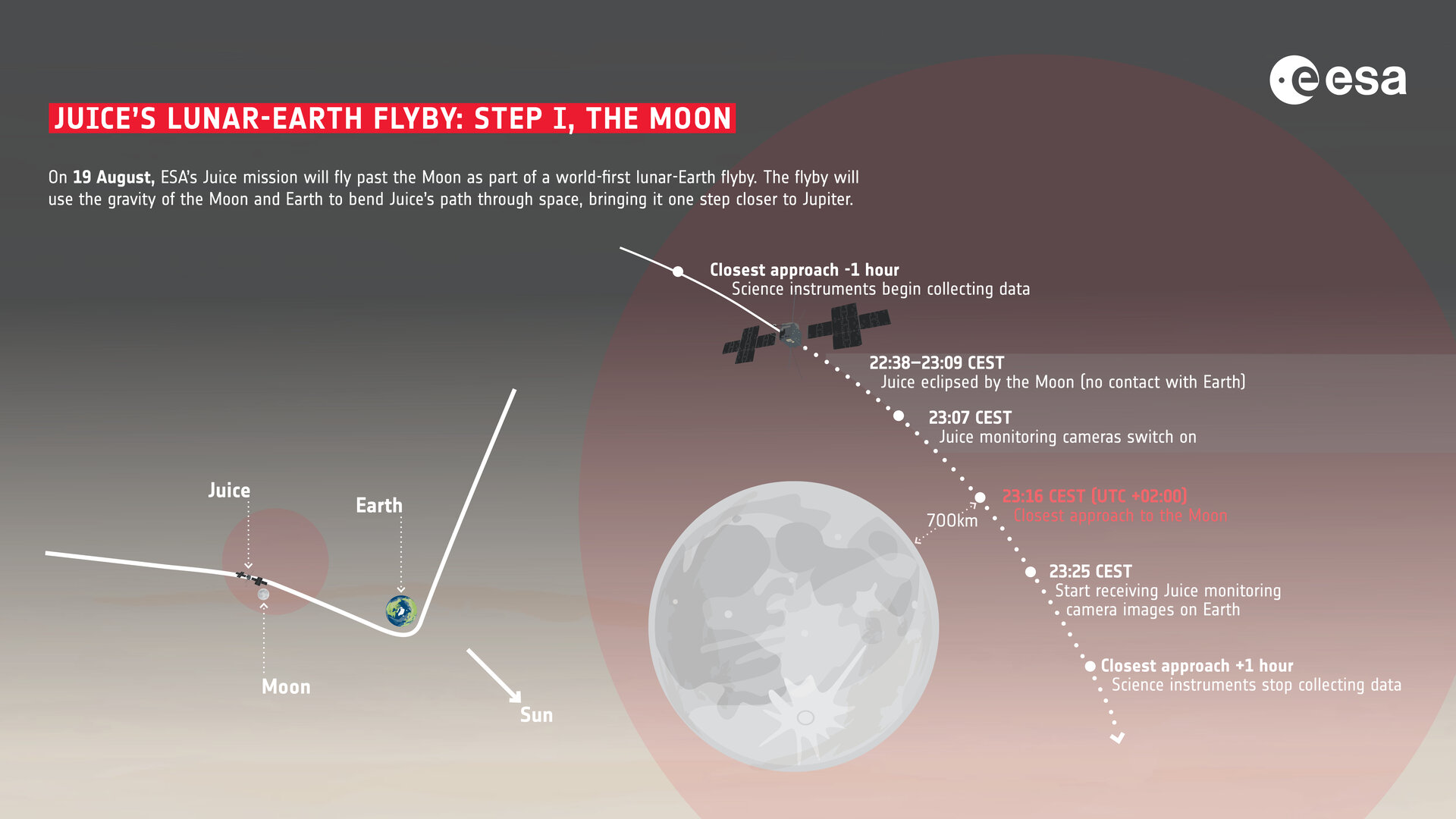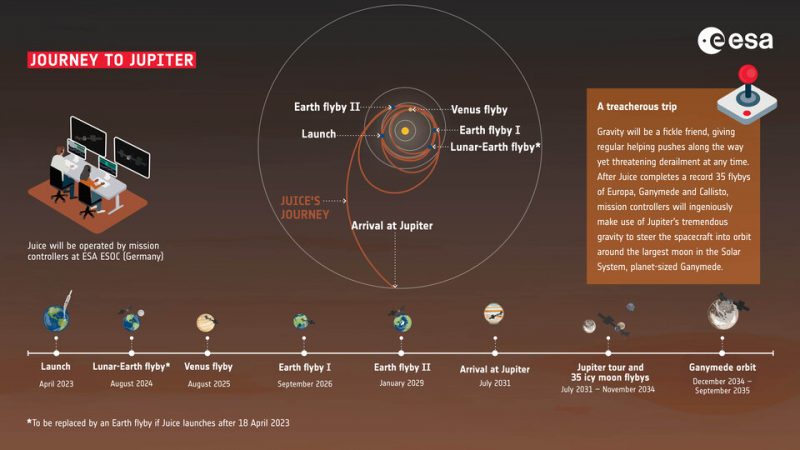Juice mission to make flyby of the moon and Earth
On August 19 and 20, 2024, the JUICE spacecraft will sweep near the moon and Earth system, coming as close as it can to both worlds before slingshotting out into space again with an altered speed and direction. These gravity assists will help propel the craft its way to Jupiter’s icy moons. It’ll be the world’s first flyby gravity assist using both Earth and its moon and the first-ever double gravity assist. The craft will encounter the moon first and then Earth, 36 hours later. The result will be a single flyby maneuver.
JUICE launched on its journey to Jupiter’s moons in 2023. This will be its first gravity assist, followed by one using Venus in 2025, and two more using Earth in 2026 and 2029, before arriving in Jupiter’s vicinity in 2031.
The flybys of the moon and Earth are technically braking maneuvers. They’ll line JUICE up to reach Venus, where the gravity assist will work to speed up the spacecraft, or give it the juice, if you will. The spacecraft will come within 430 miles (700 km) of the moon and about 4,300 miles (6,800 km) of Earth during the flybys. Ignacio Tanco of ESA said:
It’s like passing through a very narrow corridor, very, very quickly: pushing the accelerator to the maximum when the margin at the side of the road is just millimeters.
Science and observations
JUICE’s 10 instruments will be active as the spacecraft makes its flybys. It’s an important opportunity to test the equipment before it reaches Jupiter. In particular, the Radar for Icy Moon Exploration (RIME) instrument will get eight minutes of solo observation as it passes the moon. The instrument is sensitive to other electronic noise.
When the spacecraft passes overhead, people in Southeast Asia and the Pacific have an opportunity to see it pass. Try using binoculars or a telescope, and get more info on its path here. Plus, while you’re looking up at Juice, it will be looking down at us. Expect to see images of Earth from Juice soon after the flyby!
Graphics for the moon and Earth flyby


JUICE mission launched on April 14, 2023
ESA‘s JUICE mission launched on April 14, 2023, after a one-day delay due to lightning at its spaceport in French Guiana. The spacecraft lifted off successfully into cloudy skies, beginning a multi-year mission to Jupiter and its icy moons.
As often happens with missions to the outer solar system, the spacecraft will take a circuitous route to Jupiter, making multiple sweeps past the Earth, moon and Venus. Then, starting in 2031, it’ll arrive at the giant planet. At that time it’ll perform 35 flybys of the Galilean moons Ganymede, Callisto and Europa, before going into orbit around the largest moon, Ganymede.
JUICE stands for JUpiter Icy Moons Explorer.

Jammed antenna
The JUICE mission’s primary antenna jammed soon after launch. But after 3 weeks of troubleshooting, engineers finally managed to fix the antenna. As the spacecraft traveled through deep space, JUICE mission control tried using thrusters to shake the antenna. Then they tried warming the jammed components in the sun. Finally, the team fired a mechanical device called an actuator. And that’s what made the antenna break free from its stuck position on May 12, 2023. This RIME antenna, which stands for Radar for Icy Moons Exploration, will be used to study the structure of Jupiter’s icy moons down to a depth of 5.5 miles (9 km) when it finally reaches the gas giant in July 2031.
? Shocking RIME update ?
The RIME antenna on @ESA_JUICE is free!!!
This Juice Monitoring Camera GIF shows the moments after the Flight Control Team at ESA #MissionControl fired the remaining ‘actuator’ on the jammed bracket.
More info: pic.twitter.com/T96RIg3hKA
— ESA Operations (@esaoperations) May 12, 2023
JUICE mission goals
ESA said its goals for JUICE are to:
… make detailed observations of the giant gas planet and its three large ocean-bearing moons – Ganymede, Callisto and Europa – with a suite of remote sensing, geophysical and in situ instruments.
And, ESA said, the mission will characterize these moons as both planetary objects and possible habitats.
ESA hopes that a wider study of the Jupiter system can be used as an archetype for gas giant planets and their moons, across our Milky Way galaxy.
Liftoff for humankind’s next bold mission to the outer Solar System – #ESAJuice onboard @Ariane5 #VA260 ? ?#DestinationJupiter #ExploreFarther
— ESA’s Juice mission (@ESA_JUICE) April 14, 2023
Why JUICE will study Europa
JUICE will arrive at Jupiter in 2031. One of the moons it will observe is perhaps the most fascinating of the Jovian moons to Earthly scientists: Europa. This moon is thought to have an ocean of liquid water under its ice crust (also made of water ice). And JUICE is designed to look for the sort of chemistry on Europa that is essential to life on Earth … For example, organic molecules, or molecules containing carbon that are key to life on Earth.
JUICE also aims to understand the formation of Europa’s surface features and the composition of any non-water-ice material.
Why JUICE will study Ganymede
After a series of flybys of Jupiter and three of its large, icy moons, JUICE will eventually settle into an orbit around the largest moon, Ganymede. JUICE will orbit Ganymede down to 125 miles (200 km) for about three years. It’ll end its mission with an impact on the moon’s surface.
While at Ganymede, JUICE has many science objectives. They include:
- Characterization of the ocean layers and detection of possible subsurface water reservoirs.
- Topographical, geological and compositional mapping of the surface.
- Study of the physical properties of the icy crusts.
- Characterization of the internal mass distribution, dynamics and evolution of the interiors.
- Investigation of the exosphere.
- Study of Ganymede’s intrinsic magnetic field and its interactions with the Jovian magnetosphere.
Having a better understanding of this wet, cold world will also help us understand possible distant worlds around other suns, scientists say.
JUICE mocktails
Earlier this year, ESA had a little fun with the acronym JUICE, by holding a space juice contest. Check out these beautiful mocktails, and find the recipes here.

JUICE art, from kids
ESA also invited kids from around the world to create JUICE-inspired artwork. Read more about the contest here. The winning entry – submitted by 8-year-old Yaryna from Ukraine – is going to space! It’s painted on the Ariane 5 rocket, which will launch JUICE.
Did you spot the beautiful artwork on the nose of the #Ariane5 fairing? Children from all over the world were invited to create a piece of art inspired by #ESAJuice and the winning design by ten-year-old Yaryna can be seen here. pic.twitter.com/i5c7aGbTmw
— ESA’s Juice mission (@ESA_JUICE) April 12, 2023
Bottom line: The JUICE mission will make a flyby of the moon and Earth on August 19 and 20, 2024. It’ll be the 1st-ever double gravity assist. Read more here.
Read more: Icy moons’ puzzling features may be due to salty ice